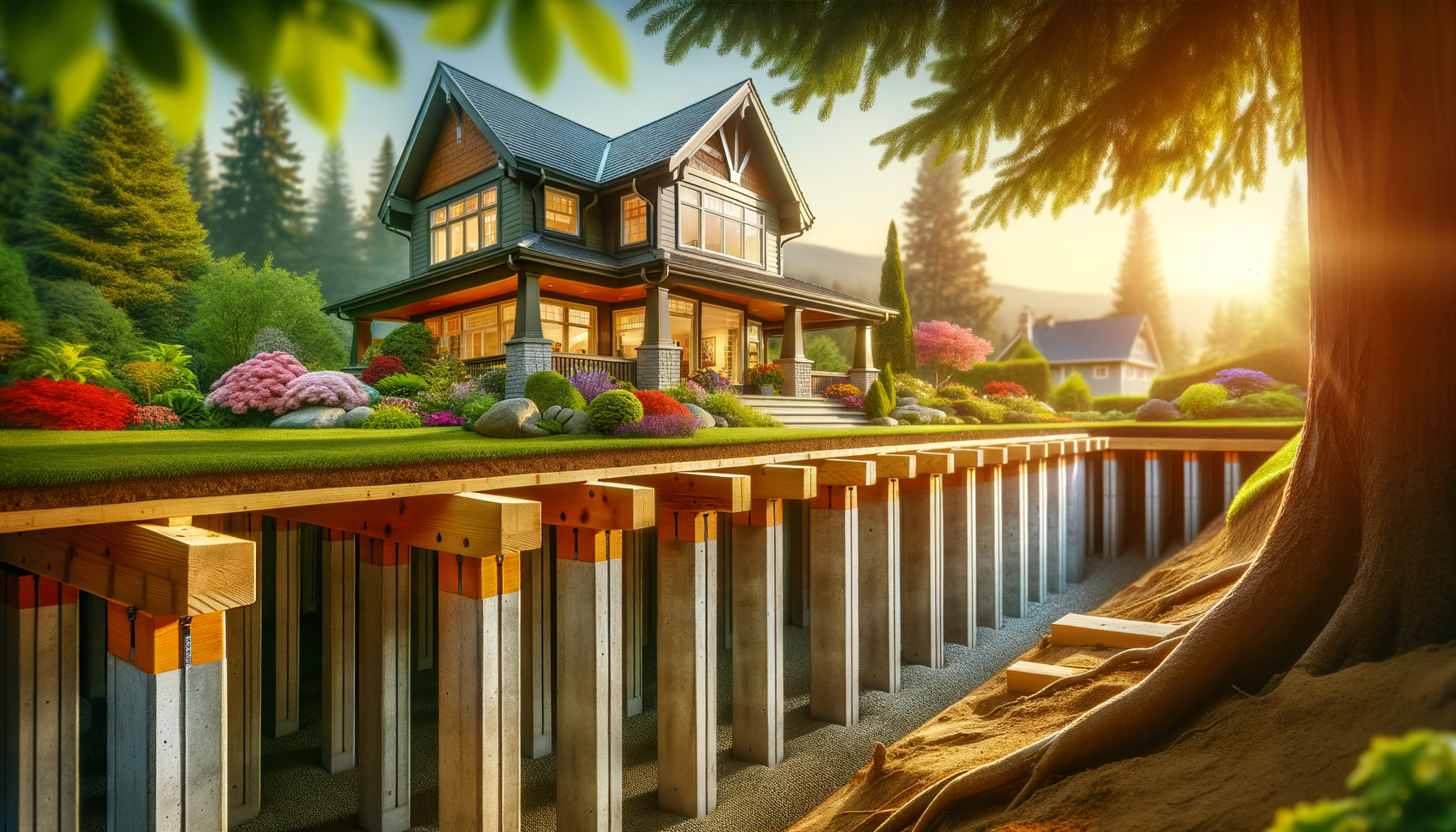Understanding Pier and Beam Foundations
What is a Pier and Beam Foundation?
A pier and beam foundation uses concrete columns (piers) to hold up wooden or metal beams, which then support your home’s flooring. This type of foundation is typical in older Canadian homes and creates a crawl space between the ground and the house.
Benefits of Pier and Beam Foundations
- Easier Access to Plumbing and Electrical Systems: The crawl space allows you to reach plumbing and electrical systems more easily, making repairs and upgrades simpler.
- Better Insulation and Ventilation: The space under the house can be insulated and ventilated, lowering energy costs and stopping moisture buildup.
- Durable in Different Climates: These foundations work well in various soil types and weather conditions, which is great for Canada’s diverse climate.
Signs Your Pier and Beam Foundation Needs Repair
Visible Cracks and Gaps
- Cracks in Interior Walls and Ceilings: Look for new or growing cracks in the walls or ceiling.
- Gaps Between Walls and Floors: Gaps can mean the foundation is moving or settling.
Uneven or Sagging Floors
- Floors that Dip or Slope: You might feel uneven floors when walking on them.
- Soft or Bouncy Spots: These can show weak or damaged beams.
Moisture Problems
- Dampness or Standing Water Under the House: Water pooling in the crawl space is a serious sign.
- Mold or Mildew Presence: Mold on wooden parts can mean there’s too much moisture.
Doors and Windows Misalignment
- Doors and Windows that Stick or Don’t Close Properly: This can mean the foundation is shifting.
Common Causes of Foundation Problems
Soil Movement and Erosion
- Expansive Clay Soils: These soils change size with moisture, causing foundation shifts.
- Soil Erosion from Poor Drainage: Bad drainage can wash away soil, weakening the foundation.
Water Damage
- Plumbing Leaks: Leaks can make the soil too wet, causing foundation issues.
- Improper Slope of the Yard: Water should flow away from the house, not towards it.
Age and Deterioration
- Rotting Wooden Beams: Over time, wood can rot from moisture.
- Rusted Metal Piers: Rust can weaken metal supports, hurting the foundation’s strength.
DIY Inspection Tips
Checking the Crawl Space
- Shine a Light Under the House: Look for wet areas or standing water.
- Look for Standing Water or Damp Areas: Check any water signs carefully.
Using a Level on the Floor
- Place a Level on Different Parts of the Floor: See if the bubble is in the center.
- Note Areas Where the Bubble Isn’t Centered: These spots might have uneven foundation support.
Monitoring Cracks Over Time
- Take Pictures and Measurements of Cracks: Track their size and location.
- Keep a Log of Changes: Regular checks can show growing problems.
Professional Repair Solutions
Shimming and Adjusting Beams
- Adding Shims to Level Out Beams: Thin pieces of material can level beams.
- When to Consult a Professional: If shims don’t fix the problem, call a foundation expert.
Replacing Damaged Wooden Components
- Removing and Replacing Rotted Beams: Carefully replace decayed beams.
- Types of Wood to Use for Replacements: Treated lumber resists moisture and decay.
Installing Additional Piers
- Reinforcement with New Piers: Adding piers can make the foundation stronger.
- Materials Used: Concrete, Steel, or Helical Piers: Each material has its own benefits.
Fixing Drainage Issues
- French Drains and Sump Pumps: These tools help manage water around the foundation.
- Proper Grading Around the Foundation: Make sure the ground slopes away from the house.
Costs and Considerations
Average Repair Costs
- Typical Cost Ranges for Different Types of Repairs: Costs vary based on the extent of the damage.
- Factors That Influence Costs: Extent of Damage, Accessibility: Severe issues or hard-to-reach areas can be more expensive.
Hiring a Contractor
- How to Find a Reliable Foundation Repair Specialist: Look for experienced and reputable professionals.
- Questions to Ask Before Hiring: Check their experience, warranty, and references.
Preventive Measures
Maintaining Proper Drainage
- Ensuring Gutters and Downspouts Direct Water Away: Keep gutters clean and extend downspouts.
- Landscaping Tips to Avoid Water Pooling: Use plants and slopes to manage water flow.
Regular Inspection and Maintenance
- Seasonal Checks for Moisture and Structural Issues: Regular inspections can catch early signs of trouble.
- Routine Maintenance for Beams and Piers: Watch the condition of structural parts.
Proper Ventilation
- Ensuring Adequate Airflow in Crawl Spaces: Good ventilation stops moisture buildup.
- Preventing Moisture Buildup: Use dehumidifiers or fans if needed.
The Importance of Timely Repairs
Fixing pier and beam foundation problems early can stop minor issues from becoming major ones, ensuring your home stays stable and safe.
Staying Informed and Proactive
Regular checks and maintenance, along with knowing when to call a professional, will keep your pier and beam foundation in good shape.
By following these tips, Canadian homeowners can keep their pier and beam foundations strong and enjoy the benefits these foundation systems offer.


Leave a Reply